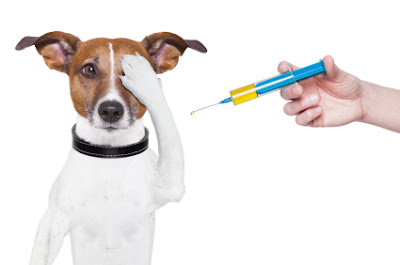Vaccination continues to be a safe, reliable and effective way of protecting animals against major infectious diseases.
Neverthless, the use of vaccines is not free risk.
Residual virulence and toxicity, allergic responses, disease
in immunodeficient hosts, neurological complications and harmful effects on the
fetus are the most significant risks associated with the use of vaccines.
Before using a vaccine, the veterinarian should consider
both the likelihood that an adverse
event will happen, as well as the possible consequences or severity of this
event.
Now in the next image you can see how we can classify the
several consequences of vaccination, of course we will take one by one, and we won't
extend to much on them, so let's see.
Normal Toxicity
The most common reactions to vaccines are local ones. For
example, an immediate form of toxicity is the sting produced by some
inactivating agents such as formaldehyde. This can present problems, not only
to the animal being vaccinated but also, if the animal reacts in a violent way
towards the vaccinator or Veterinarian, like biting or scratching (as most cats
do),it can turn into a stressful situation for all parties involved in the
consultation room.
More commonly, local swellings may develop at the reaction
site. These may be firm or edematous and may be warm to the touch. They appear
about one day after vaccination and can last for about a week. Unless an
injection site abscess develops, these swellings leave little trace.
Vaccines containing gram-negative organisms (such as
bordetella bronchiseptica), may be intrinsically toxic, owing to the presence
of endotoxins that can cause cytokine release, leading to shock, fever, and
leukopenia.
Even when the reaction is usually temporary, it may be
enough to provoke abortion in pregnant females.
Inappropriate Responses
Vaccines may cause allergic reactions, for example: Type I
hypersensitivity can occur in response not only to the immunizing antigen but
also to other antigens found in vaccines, such as egg antigens from tissue
culture cells.
 Type I Hypersensitivity is an immediate response to an
antigen and occurs within a few minutes or hours after exposure to an antigen.
Reactions occurring more than 2 or 3 hours after administration of a vaccine
are likely not type I hypersensitivity reactions.
Type I Hypersensitivity is an immediate response to an
antigen and occurs within a few minutes or hours after exposure to an antigen.
Reactions occurring more than 2 or 3 hours after administration of a vaccine
are likely not type I hypersensitivity reactions.
Type III Hypersensitivity reactions are also potential
hazards, they can cause intense local inflammation, or they may present
generalized vascular disturbance such as purpura. They can occur in the eyes of
dogs vaccinated against infectious canine hepatitis. Some rabies vaccines may
induce a local complement-mediated vasculitis leading to ischemic dermatitis
and local alopecia (this is more often seen in small dogs).
A common Type IV Hypersensitivity reaction is granuloma
formation at the site of inoculation. This may be a response to depot adjuvants
containing alum or oil. Vaccines containing a water-in-oil adjuvant produce
larger and more persistent lesions at injection sites than vaccines containing
alum and aluminum hydroxide. These lesions can be granulomas or sterile
abscesses. If the skin is dirty at the injection site, these abscesses may
become infected.
So of course we as Veterinarians have to be very careful with not only the handle we give the animals at the time of the vaccinations, but also we have to be very careful on what kind of vaccines shall we give the animals, keep them under observation, and of course the safety rule I will always apply, never put more than 2 vaccines in one visit, and never place them in the same site, specially on puppies and kittens.
So what are your thoughts on the vaccines? Has any of your patients ever had a vaccine reaction?
We will continue going through these vaccine consequences soon!
MVZ Carolina Pruneda



No hay comentarios:
Publicar un comentario